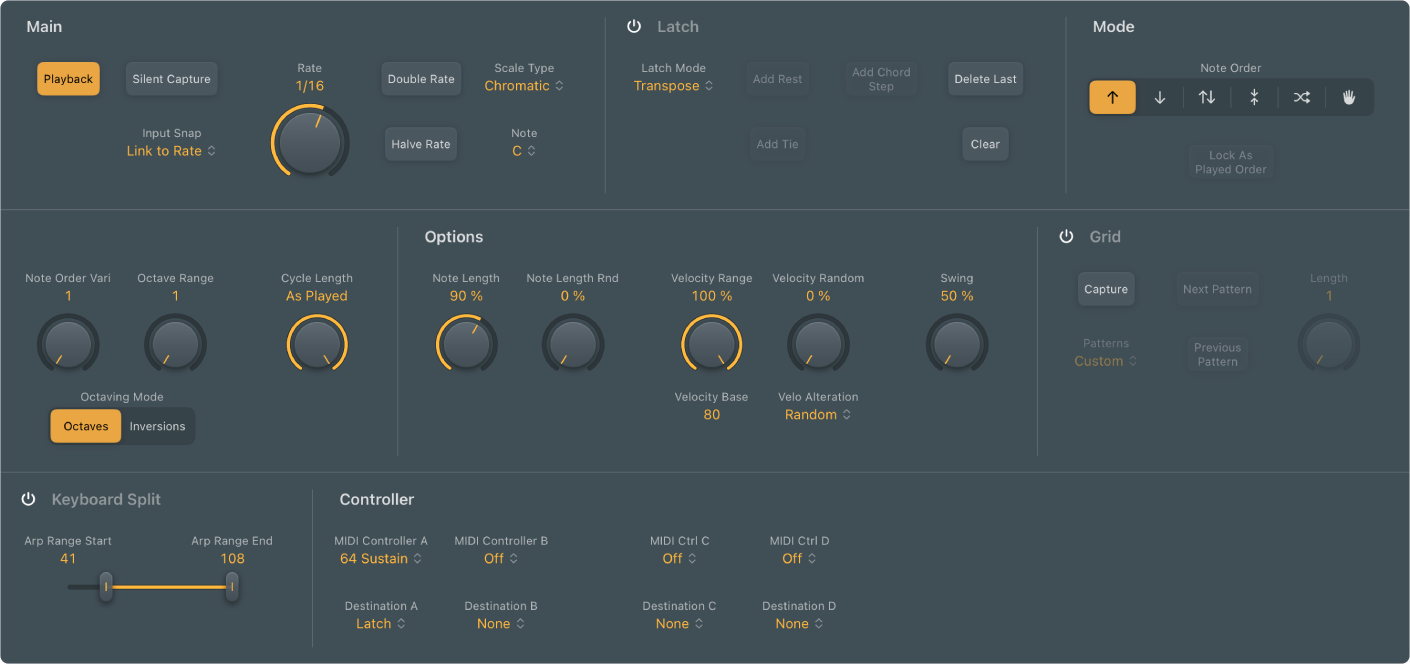Logic Pro User Guide for iPad
- What’s new in Logic Pro 1.1
-
- What is Logic Pro?
- Working areas
- Work with function buttons
- Work with numeric values
-
- Intro to tracks
- Create tracks
- Create tracks using drag and drop
- Choose the default region type for a software instrument track
- Select tracks
- Duplicate tracks
- Reorder tracks
- Rename tracks
- Change track icons
- Change track colors
- Use the tuner on an audio track
- Show the output track in the Tracks area
- Delete tracks
- Edit track parameters
- Start a Logic Pro subscription
- How to get help
-
- Intro to recording
-
- Before recording software instruments
- Record software instruments
- Record additional software instrument takes
- Record to multiple software instrument tracks
- Record multiple MIDI devices to multiple tracks
- Record software instruments and audio simultaneously
- Merge software instrument recordings
- Spot erase software instrument recordings
- Replace software instrument recordings
- Capture your most recent MIDI performance
- Use the metronome
- Use the count-in
-
- Intro to arranging
-
- Intro to regions
- Select regions
- Cut, copy, and paste regions
- Move regions
- Remove gaps between regions
- Delay region playback
- Trim regions
- Loop regions
- Repeat regions
- Mute regions
- Split and join regions
- Stretch regions
- Separate a MIDI region by note pitch
- Bounce regions in place
- Change the gain of audio regions
- Create regions in the Tracks area
- Convert a MIDI region to a Drummer region or a pattern region
- Rename regions
- Change the color of regions
- Delete regions
- Create fades on audio regions
- Access mixing functions using the Fader
-
- Intro to Step Sequencer
- Use Step Sequencer with Drum Machine Designer
- Record Step Sequencer patterns live
- Step record Step Sequencer patterns
- Load and save patterns
- Modify pattern playback
- Edit steps
- Edit rows
- Edit Step Sequencer pattern, row, and step settings in the inspector
- Customize Step Sequencer
-
- Effect plug-ins overview
-
- Instrument plug-ins overview
-
- ES2 overview
- Interface overview
-
- Modulation overview
-
- Vector Envelope overview
- Use Vector Envelope points
- Use Vector Envelope solo and sustain points
- Set Vector Envelope segment times
- Vector Envelope XY pad controls
- Vector Envelope Actions menu
- Vector Envelope loop controls
- Vector Envelope release phase behavior
- Vector Envelope point transition shapes
- Use Vector Envelope time scaling
- Use the Mod Pad
- Modulation source reference
- Via modulation source reference
-
- Sample Alchemy overview
- Interface overview
- Add source material
- Save a preset
- Edit mode
- Play modes
- Source overview
- Synthesis modes
- Granular controls
- Additive effects
- Additive effect controls
- Spectral effect
- Spectral effect controls
- Filter module
- Low and highpass filter
- Comb PM filter
- Downsampler filter
- FM filter
- Envelope generators
- Mod Matrix
- Modulation routing
- Motion mode
- Trim mode
- More menu
- Sampler
- Copyright
Arpeggiator MIDI plug-in in Logic Pro for iPad
The Arpeggiator MIDI plug-in generates musically interesting arpeggios based on incoming MIDI notes. It provides split and remote features that let you control nearly all Arpeggiator functions without taking your hands off the keyboard, making it a powerful live performance tool.
An arpeggio is a succession of notes in a chord. Rather than all notes being played at one time, they are played one after the other in a pattern: up, down, random, and so on. The Arpeggiator plug-in provides a number of preset patterns, inclusive of switchable variations and inversions. Inversions change the root note of the chord from the lowest note, resulting in a different start note in arpeggiated patterns. These features let you quickly switch between patterns and feels when performing live, or when creating new projects in the studio.

The Arpeggiator MIDI plug-in is divided into four main function areas.
Main and Latch parameters: This area contains the Play and Latch controls. See Arpeggiator main parameters and Arpeggiator latch parameters.
Mode parameters: Here you can set note order parameters, can determine the arpeggio type and include four variations or inversions, the arpeggio octave range, and the arpeggio speed. See Arpeggiator note order parameters.
Options and Grid parameters: The options parameters provide control of note lengths and velocities, and the overall swing amount of the Arpeggiator. The grid parameters let you capture and load arpeggiator patterns.
Control parameters: Arpeggiator parameters and behavior can be modified with keyboard parameters and controller parameters.
Download this guide: PDF